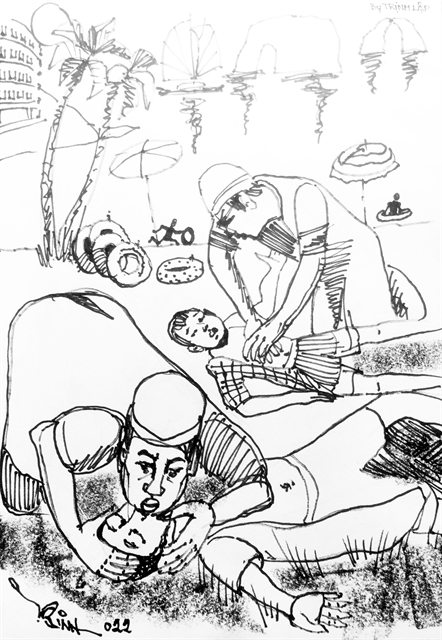
Illustration by Trịnh Lập
by Nguyễn Mỹ Hà
In the first weeks of April, a number of water-related accidents put several lives at risk. But thanks to the bravery and quick thinking of Police Lieutenant Thái Ngô Hiếu from the Đồng Nai Province Fire Prevention and Rescue Unit, and Nguyễn Đức Chính from the seaside Hải Hậu District of Nam Định Province, lives were saved.
As recognition and encouragement, President Nguyễn Xuân Phúc promptly praised the men, thanking them for risking their lives to save others.
Lt Hiếu saved four youths from drowning off a beach in Bà Rịa Vũng Tàu Province , and Chính from Nam Định jumped from a height of 30m to escort an eighth-grader safely to shore.
Every summer, there are reports of drowning casualties, where schoolchildren take year-end summer camps or venture out of their school to refresh themselves from the summer heat in lakes, ponds and rivers.
Việt Nam is a country with a 3,000km long coastline, and a sophisticated network of springs and rivers, so public awareness of the need to protect young people, particularly small children from the danger of drowning is essential. We need more practical tools to save lives.
I was hoping the President would call on all local authorities to put up warning signs at river wharves, local irrigation canals, or village ponds where children have been seen bathing. The warnings need to be a little more sophisticated than just, "Danger, no swimming allowed" or "Deep pond, swimming forbidden!"
We need more instructive signs, and lifebuoys and life vests need to be ready ahead of time, not ordered after the fact when it is too late.
If concerted efforts are activated from the top-down, with sports companies providing facilities, local government budgets pitching in, youth organizations taking action, supervision from the grassroots women's union and, above all, alert parents and children, many lives could be saved.
It's impossible to say if enough preventive measures have been carried out because accidents occur when we're least prepared, but it's always never too late to be proactive and alert.
A popular saying "Nhà có phúc sinh con biết lội," literally translates as "It is a family's fortune to have a child who can swim." But even when every child can swim, we still need to have warning signs and location instructions.
"I am an adult, and I almost lost my life to drowning," reads a notice from a man in his 30s in a marathon running community.
"But I learned how to swim thanks to the Red River. I understand the desperation when you can't swim, and I wish to contribute a small part to helping children living in 10 provinces along the Red River to swim."
Nguyễn Ngọc Khánh, 35, travels to Lào Cai Province this weekend to meet with another volunteer to teach children to swim. An employee for a Japanese import-export company based in Hà Nội, Khánh will spend all his weekends for the next 10 weeks travelling to 10 provinces along the Red River to help with swimming lessons.
Discovery Swim and Red River Supper Club members will head to provincial gatherings to share tips and techniques to help volunteers teach more children.
If you are a swimming coach, if you can swim but cannot teach you can provide safety equipment, if you can perform first aid, or if you want to accompany the Discovery Swim and Red River Supper Club, everyone is welcome.
On May 3, the Prime Minister's office announced a decision to enhance the protection of children and their rights, emphasising the dangers of drowning.
The Ministry of Labour, War Invalids and Social Affairs will also work to this effect in provinces where a high number of child drownings have been recorded. Further policy and strategy changes shall also be made.
The Ministry of Education and Training must implement the general knowledge and skills to prevent drowning, with students receiving guidance, especially before the summer break. A campaign to promote swim lessons in schools will also start soon.
The Prime Minister has emphasised the need for teachers and parents to work closely to supervise child swimming lessons. Addressing provincial governments, he also said that the Children Protection committees at grassroots levels and local volunteers need to keep a close eye on children when they are not at school, especially during the summer break, and before and during storms and floods.
He said that a warning map alerting people to sites with high drowning risks should be issued.
Local governments need to allocate budgets to implement child warning and protection equipment, open safe classes to teach swimming to children and assist with the associated costs.
"It's hard to do all these things all at once," Khánh said upon hearing about the policy. "Because local officials may not love swimming, they may not see the importance of swimming skills."
Let's hope he is proved wrong because children being able to swim is an issue of the utmost importance.
The new policy direction is just being worked out and it's not yet known how the focus will evolve and unwrap this summer, but if the government sees the importance and people support it, we will get where we need to be on child water safety and lives will surely be saved. VNS
OVietnam